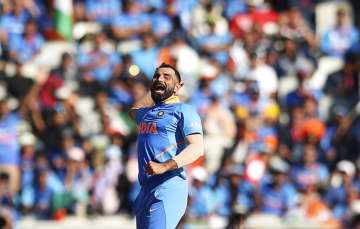Mohammed Shami 2.0: The lean, mean pace machine who means business
Mohammed Shami has taken 8 wickets in two World Cup games so far since coming into the side for an injured Bhuvneshwar Kumar.

12 months ago, Mohammed Shami failed a YoYo test, ruling him out of the one-off test against Afghanistan. It was a big blow for Shami, who had already been out of India’s ODI prospects. The turmoil in his personal life had made the situation worse for him.
In 6 months, Mohammed Shami was firing down at Aussie and Kiwi batsmen in blue colours across the two Oceanic nations. He had taken 12 wickets in 6 games in January in two separate series and secured his spot in the squad for the World Cup.
-
12 days ago, Bhuvneshwar Kumar suffered from an injury against Pakistan, which ruled him out of at least 2-3 games. Shami, who had been waiting patiently on the sidelines for one big chance, knew that it was his time to step up.
In 6 days, Mohammed Shami had gone from being a back-up option to becoming India’s only second bowler to take a World Cup hattrick. In another six, he registered his best career bowling figures in ODIs.
-
Shami’s rise in limited-overs format may look sudden to the naked eye, but to say that would be to drift far away from the truth. The bowler has worked incredibly hard on his fitness, as well as on his bowling, and the results hardly look surprising.
Shami made a solid start to his international career, becoming the fastest Indian to take 50 wickets in ODI cricket. Fitness issues surfaced and professional problems kept Shami out of the limited overs team for almost a year between 2017 and 2018. He was selected for the ODI series in South Africa in the 2018 tour, but didn’t play a single game. After he failed his fitness test, India looked for other bowling options in Khaleel Ahmed and Shardul Thakur as well.
Team India’s fitness coach Shankar Basu reveals that he was not entirely confident on Shami regaining his fitness, prompting Basu to also proudly declare that a fit Mohammed Shami is his greatest achievement.
“He failed a fitness test last year and also had some issues in his personal life. Once he came back, he started training with a vengeance. I had told Shami that there is no point of training hard for 20 days,” he recalls.
“You have to train consistently. Now training is his lifestyle. Look at how his pace never drops even in the final test of a five-game series,” Basu says. He further adds that Shami is among the first player in the Indian team to start the concept of intermittent fasting.
Even as Shami returned to the team, he was an improvement to the fastest-to-50-wickets version of self. Shami was now emerging as an impact bowler – someone who could allow his colleagues some breathing space, while he continues to make life hell for the batsmen. In both the games of the World Cup, he showcased his use to full effect.
Shami, alongside Bumrah, struck at vital moments against Afghanistan and the West Indies. He struck in the powerplays, and he struck in the middle-overs. He hadn’t even bowled 120 deliveries in the World Cup, and already clipped 8 wickets.
-
If Mitchell Starc hadn’t already ended the English hopes at Lord's with a reverse-swinging yorker which almost led Ben Stokes to break his bat, Shami’s delivery to Shai Hope could’ve been a top contender for the delivery of the tournament at this World Cup. He kept it full, and the ball came in. Before Hope could react, before the on-lookers could even surmise what had happened, Shami was celebrating, and signalling Hope to move on.
The delivery almost summarized Mohammed Shami’s comeback in some ways. He had arrived at the heat of the moment, and made it too unbearable for the batsmen to survive the fire burning within.